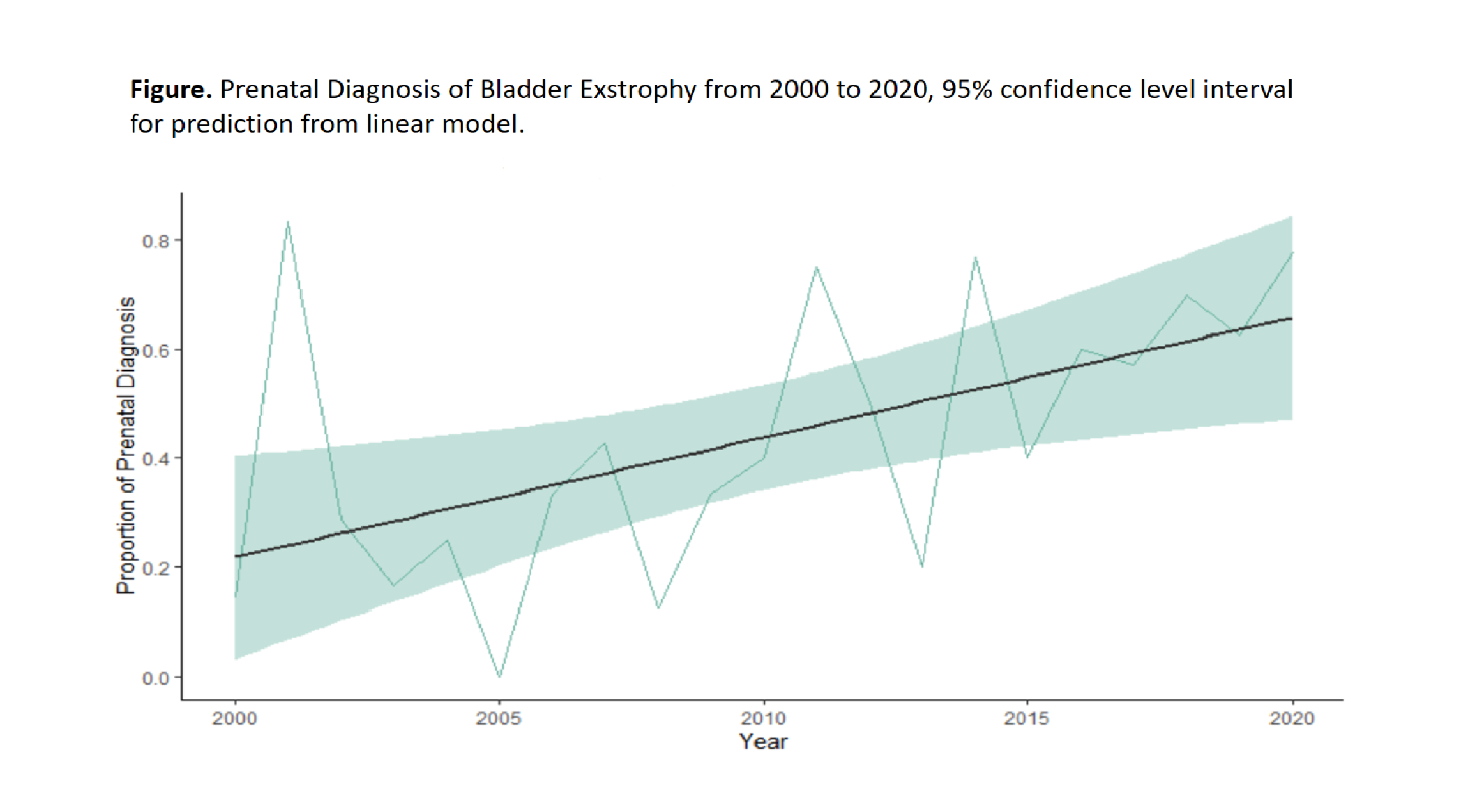Back
Poster, Podium & Video Sessions
Moderated Poster
MP11: Pediatric Urology: Neurogenic Bladder, Reconstruction & Urologic Emergencies
MP11-12: Prenatal Diagnosis of Bladder and Cloacal Exstrophy over 20 Years
Friday, May 13, 2022
1:00 PM – 2:15 PM
Location: Room 225
Ted Lee*, Boston, MA, Dana Weiss, Philadelphia, PA, Elizabeth Roth, Milwaukee, WI, Sahar Eftekharzadeh, Philadelphia, PA, Saafia Masoom, Boston, MA, Susan Jarosz, John Kryger, Milwaukee, WI, Aseem Shukla, Philadelphia, PA, Travis Groth, Michael Mitchell, Milwaukee, WI, Richard Lee, Boston, MA, Douglas Canning, Philadelphia, PA, Joseph Borer, Boston, MA
- TL
Poster Presenter(s)
Introduction: Bladder exstrophy (BE) and cloacal exstrophy (CE) presents significant challenges during the newborn period. In contrast to the unexpected diagnosis in the newborn, prenatal diagnosis of BE and CE affords valuable opportunities for education and preparation for caregivers and healthcare providers. Based on small sample populations, previously reported prenatal diagnosis rates of BE and CE were 13-25% and 17%, respectively. In this study, we aimed to examine the prenatal diagnosis rates of BE and CE in a large cohort of patients over a 20-year period. We hypothesized that prenatal diagnosis rates improved over time in both BE and CE due to evolving techniques and technologies in prenatal ultrasonography.
Methods: We queried a multi-institutional exstrophy-epispadias complex database of three centers to identify patients with BE or CE who underwent primary closure between 2000 and 2020. Retrospective review was performed to assess whether BE or CE diagnosis was made prenatally versus postnatally. Those with unknown prenatal history were excluded from analysis. Univariate analysis of categorical data was performed using Pearson’s Chi-square test. Multivariable logistic regression was used to investigate temporal pattern in the rate of prenatal diagnosis while adjusting for sex and institution.
Results: Among 197 BE and 52 CE patients that were identified, 155 BE and 45 CE patients had known prenatal history. The overall prenatal diagnosis rates of BE and CE were 47.1% (73/155) and 82.2% (37/45), respectively. Prenatal diagnosis rate was significantly lower in BE compared to CE (p < 0.0001) across the 20-year period. The prenatal diagnosis rate for BE significantly increased over time (OR 1.10; [95% CI: 1.03, 1.17]; p = 0.003). Between 2000 and 2005, the prenatal diagnosis rate of BE was 30.3% (10/33). Between 2015 and 2020, the prenatal diagnosis rate of BE was 61.1% (33/54). The prenatal diagnosis rate for CE did not change over time. Rates of prenatal diagnosis did not differ by sex or institution in both BE and CE.
Conclusions: The rates of prenatal diagnosis of BE and CE are higher than previously reported. Prenatal diagnosis rate of BE doubled in the last 5 years compared to the first 5 years of the study period. Nonetheless, a significant proportion of both BE and CE patients remain undiagnosed prior to delivery.
Source of Funding: None

Methods: We queried a multi-institutional exstrophy-epispadias complex database of three centers to identify patients with BE or CE who underwent primary closure between 2000 and 2020. Retrospective review was performed to assess whether BE or CE diagnosis was made prenatally versus postnatally. Those with unknown prenatal history were excluded from analysis. Univariate analysis of categorical data was performed using Pearson’s Chi-square test. Multivariable logistic regression was used to investigate temporal pattern in the rate of prenatal diagnosis while adjusting for sex and institution.
Results: Among 197 BE and 52 CE patients that were identified, 155 BE and 45 CE patients had known prenatal history. The overall prenatal diagnosis rates of BE and CE were 47.1% (73/155) and 82.2% (37/45), respectively. Prenatal diagnosis rate was significantly lower in BE compared to CE (p < 0.0001) across the 20-year period. The prenatal diagnosis rate for BE significantly increased over time (OR 1.10; [95% CI: 1.03, 1.17]; p = 0.003). Between 2000 and 2005, the prenatal diagnosis rate of BE was 30.3% (10/33). Between 2015 and 2020, the prenatal diagnosis rate of BE was 61.1% (33/54). The prenatal diagnosis rate for CE did not change over time. Rates of prenatal diagnosis did not differ by sex or institution in both BE and CE.
Conclusions: The rates of prenatal diagnosis of BE and CE are higher than previously reported. Prenatal diagnosis rate of BE doubled in the last 5 years compared to the first 5 years of the study period. Nonetheless, a significant proportion of both BE and CE patients remain undiagnosed prior to delivery.
Source of Funding: None


.jpg)
.jpg)